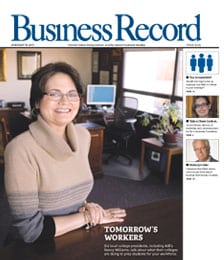Iowa Transportation Museum fundraising begins to accelerate

When it was at the height of its production capacity nearly 100 years ago, the Spaulding Carriage and Automobile Works in downtown Grinnell was Poweshiek County’s largest employer. About 400 artisans employed by Henry Spaulding were producing 10,000 wagons and buggies in 1910. That same year, the company began making handcrafted automobiles.
Though Henry Ford tinkered with the idea of buying Spaulding out, the two men’s concepts on how to build cars were miles apart, and by the late 1920s, Spaulding’s business was among hundreds of regional car makers that foundered against Ford’s assembly-line processes.
Today, the long-silent complex of remaining brick buildings, once destined for demolition by the city to make way for a new fire station, is being transformed into the Spaulding Center for Transportation, which will house the Iowa Transportation Museum. Supporters envision thousands of visitors exiting Interstate 80 each year to learn about Iowa’s transportation heritage.
For the past year, the museum’s organizers have been carefully steering limited funding into work to weatherproof and strengthen the buildings. With news of a $3.6 million earmark from the federal transportation bill in late July, the project finally seems to be shifting into a higher gear, said John Swanson, executive director of the Iowa Transportation Museum.
“We’ve received about $2 million in federal grants and we’ve got the $3.6 million appropriation. On top of that, to date, without any organized campaign, we’ve raised about $250,000,” Swanson said. Additionally, “I have two major gifts pending that are very significant. Between the two gifts, it will represent well over $1 million in more private contributions. So all of a sudden, we’re really starting to pick up speed.”
Next month, the museum plans to launch a $12 million statewide fundraising campaign in an effort to find corporate and individual sponsors, particularly businesses that are in or are dependent on the transportation industry. Swanson said he’s optimistic that at least one building of the museum will open by the end of 2006 or early 2007.
The museum’s board estimates it will take approximately $7 million to complete the restoration of the buildings, which are listed on the National Register of Historic Places, and another $16 million to outfit them with equipment and displays.
At the heart of the museum will be a restoration laboratory that will enable visitors to watch artisans refurbish vintage vehicles, boats or even aircraft. The first major project planned: restoration of the only known surviving Spaulding automobile, a 1913 model.
“We intend to put (the vehicle) back to full operating condition, and there’s no reason we can’t,” Swanson said. The car’s frame and engine, which had been used in Colorado to power a sawmill, were bought from a collector earlier this year, and through collector networks the museum located other key parts. Though the car is only 60 percent intact, the missing parts can be reliably duplicated by restoration experts, he said.
Historic Iowa autos won’t be the only things to see at the museum. The exhibits will look back at each significant era of transportation, from the earliest trails up to modern superhighways, as well as a look at the state’s role in aviation and space travel.
The museum will focus on gathering a permanent collection of vehicles and artifacts, but will also devote a large percentage of its space to changing themed exhibits to encourage repeat visits, Swanson said. Another important element will be a “traveling museum” that will take exhibits to schools throughout the state, he said. .
“We’re going to try to appeal to two distinct audiences: youths from about 7 to 13 years old; and empty-nesters, typically couples mid-40s and up, who have the time and motivation to go out and experience things. If we can reach those two groups, we’ll have covered the waterfront.”
Other elements of the planned museum include the National Transportation Heroes Center, a searchable registry of everyday transportation professionals such as career bus drivers and long-haul truck drivers. Additionally, there are plans for a regional archive and research library that could be used by both non-profit organizations and businesses. Both of these efforts are backed by the $3.6 million transportation appropriation.
Additionally, the museum complex will house a conference center, and there are plans to develop loft-style temporary housing on the third floor of one of the buildings that could be used by institutions such as Grinnell College, Grinnell Regional Medical Center or businesses to temporarily house professional visitors.
To develop the master plan for the museum, the board has contracted with Presentation Inc., a firm based in Hiawatha, and Maxwell Associates Inc., an Indianapolis-based company that developed the award-winning Indianapolis Children’s Museum.
“They will be working with us over the next six to eight months,” Swanson said. “They will be creating the entire visitor experience, from the time that you exit the highway, how you’ll be directed to parking and what you’ll see as you walk in.”
Using federal Transportation Enhancement Program funds, the Iowa Department of Transportation has awarded a total of $978,000 to the project through three grants, said Stuart Anderson, director of the DOT’s office of systems planning. The funds come from an allocation of $9 million in federal dollars made available to Iowa annually, half for statewide projects and half for regional projects. The funds can be used for trails, scenic and environmental or historic-archeological projects.
Also, the project received a $150,000 Rural Community Development Initiative grant from the U.S. Department of Agriculture, which the organization used to establish a Web site (www.iowatransportationmuseum.com) and for board members to travel to regional museums to gather ideas.
The first building planned to open, which once housed the Spaulding administration building, will probably be used to tell the company’s story and provide an overview of what the completed museum complex will look like, Swanson said.
One concept that’s being “seriously considered” is to build a glass atrium to connect the administration building with one of the adjacent buildings.
“This place was just a network of catwalks and second-story walkways that connected the various buildings,” Swanson said. “That was one of the reasons we thought, ‘It shouldn’t be hard to recapture that space, and then reopen some of these (openings) that have been bricked up over the years.’”
Another possibility being explored is to build a glass-enclosed structure in the courtyard space between the four buildings in which to display larger items such as boats or locomotives.
“These are historic buildings and we need to preserve them and restore them accurately,” he said. “But we think we can combine the historic with some contemporary looks for functional purposes. We want to use this entire site for programming and learning experiences. What parking we need will be off-site.”
As the museum’s fund-raising campaign gets going, “we’ll be approaching a mix of businesses and individuals and other organizations to reach the ($12 million) goal,” Swanson said. “This might be an outstanding opportunity, particularly for companies with an affinity for transportation, to step up to the plate to do something significant, but also to get a little recognition for themselves. It’s fine with us if they want to put their logo on the corner of the display or whatever. I think that’s only right.”
Looking up at the former factory’s brick smokestack, which a windstorm reduced to half its height years ago, Swanson smiled and said, “For $30,000, we’ll rebuild it and put your name on it.”







